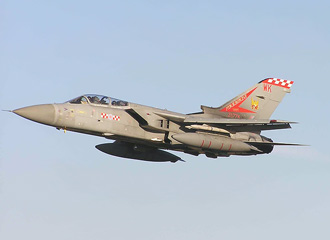
Exercise Report : CQWIC 2/2005
|
Report by Des Brennan, all photos by author.
Twice a year the RAF holds Combined Qualified Weapons Instructors Courses (CQWIC) for aircrew who have been training at their respective fast jet Operational Conversion Units (OCUs) as Qualified Weapons Instructors (QWIs). These are already highly experienced on type and return to their operational squadrons well versed in the latest tactics and operational doctrine. The CQWIC last for two weeks in June/July and November/December and involves Combined Air Operation (COMAO) exercises being flown Tuesday-Friday in week one and Monday-Thursday in week two. Overseen by the Air Warfare Centre these daily exercises cover a wide range of scenarios for packages of 30-40 aircraft striking a variety of targets to accomplish their exercise goal. This serves a dual purpose of allowing students to plan and execute operations using current tactics which can themselves be refined through such use. Use of Rangeless Airborne Instrumented De-Briefing System (RAIDS) Pods which fit standard Sidewinder launch rails allows real-time monitoring and post-exercise debriefing. In addition to the OCU aircraft types ( Tornado GR.4 from XV (R) Sqn. ; Tornado F.3 from 56 (R) ; Harrier GR.7 and T.10 from 20 (R) Sqn. and until recently Jaguar GR.3 and T.4 from 16 (R) Sqn. ) other RAF and Royal Navy units provide additional fast jet and force multiplier support. Non-UK participation has included USMC F/A-18s, Norwegian F-16`s, French and NATO AEW and most recently USAF F-15s. RAF Leuchars In recent years most CQWIC events have been held at RAF Leuchars in Fife which is roughly mid-way between the low flying areas and ranges of the Scottish Highlands to the north and Scottish Borders and Northern England to the south which avoids long transit flights and allows operating aircraft to take off almost straight into their exercise roles. The exercise area is selected daily depending on the weather and the relevant task allocated to the CQWIC Students who then have to prepare their operational plan, conduct general and formation briefings prior to a preset launch time, usually in the early afternoon. To limit noise nuisance in the vicinity aircraft formations taking part launch in fairly rapid succession over about an hour with landings being even more concentrated. CQWIC - November 2005 The second course for 2005 was held at Leuchars between 14th-25th November. Due to normal aircraft rotation within the various communities participating aircraft wore a wide variety of squadron markings which did not necessarily reflect the identities of the units using them. These included:-
My images were taken on a visit to Leuchars on 17th. November with 38 aircraft flying. These were:
|
|
|||||||||||||||||||||||||||||||||||||||
With thanks to Flt. Lt. Wardlaw, Corporate Communications Officer, RAF Leuchars for arranging the photo-opportunity.
Report and photos by Des Brennan ( view portfolio )
First Published: 2 January 2006
Last Modified: 22 March 2013
Last Modified: 22 March 2013






































 Back to Index
Back to Index